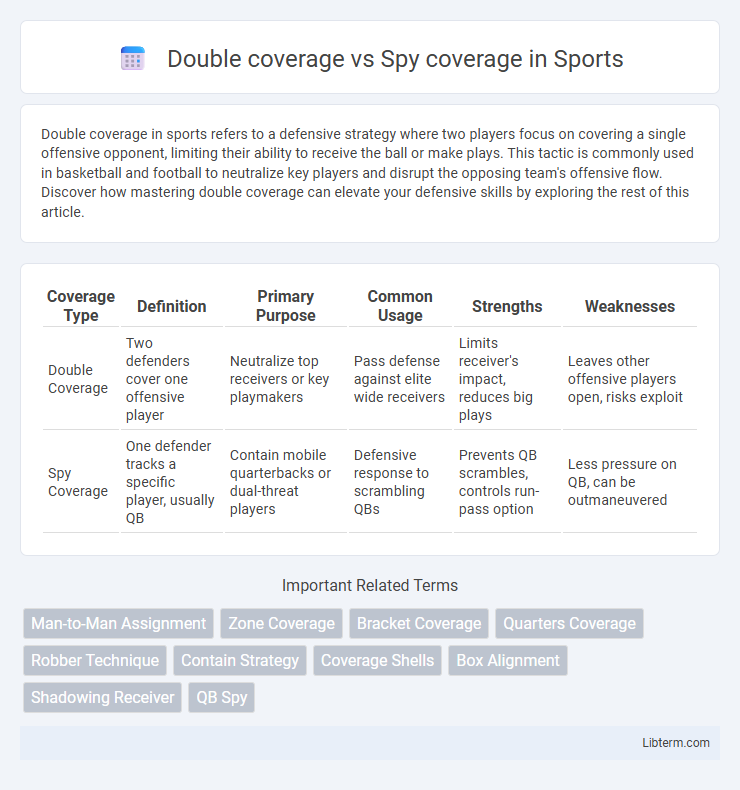Double coverage in sports refers to a defensive strategy where two players focus on covering a single offensive opponent, limiting their ability to receive the ball or make plays. This tactic is commonly used in basketball and football to neutralize key players and disrupt the opposing team's offensive flow. Discover how mastering double coverage can elevate your defensive skills by exploring the rest of this article.
Table of Comparison
| Coverage Type | Definition | Primary Purpose | Common Usage | Strengths | Weaknesses |
|---|---|---|---|---|---|
| Double Coverage | Two defenders cover one offensive player | Neutralize top receivers or key playmakers | Pass defense against elite wide receivers | Limits receiver's impact, reduces big plays | Leaves other offensive players open, risks exploit |
| Spy Coverage | One defender tracks a specific player, usually QB | Contain mobile quarterbacks or dual-threat players | Defensive response to scrambling QBs | Prevents QB scrambles, controls run-pass option | Less pressure on QB, can be outmaneuvered |
Introduction to Double Coverage and Spy Coverage
Double coverage assigns two defenders to tightly guard a single offensive player, minimizing their impact by limiting receiving options and forcing the quarterback to find alternatives. Spy coverage designates a defender to monitor and react specifically to a key offensive player, often a mobile quarterback, preventing them from scrambling or exploiting open spaces. Both strategies adapt defensive focus on high-threat opponents but differ in allocation of resources and tactical objectives.
Key Differences Between Double Coverage and Spy Coverage
Double coverage involves assigning two defenders to cover a single offensive player, typically a star receiver or tight end, to limit their impact by reducing their receiving options. Spy coverage assigns a defender, often a linebacker or safety, to monitor and react to the movements of a specific offensive player, usually the quarterback, focusing on containment and preventing scrambles rather than direct pass coverage. Key differences include double coverage's emphasis on pass defense by closely marking a receiver, while spy coverage prioritizes tracking and containing a mobile player's actions, often leaving other offensive options less tightly covered.
Situational Usage: When to Use Double Coverage
Double coverage is most effective against elite receivers who consistently dominate one-on-one matchups, particularly in critical red zone situations or during third downs where preventing a big play is paramount. Defensive coordinators deploy double coverage to limit the target's reception opportunities, forcing quarterbacks to rely on less-preferred options. This strategy contrasts with spy coverage, which is better suited for tracking mobile quarterbacks or versatile offensive threats rather than limiting a single receiver's impact.
Situational Usage: When to Deploy Spy Coverage
Spy coverage is deployed primarily to contain dynamic playmakers or mobile quarterbacks known for scrambling and extending plays, allowing the defense to limit their impact without sacrificing entire zones. Double coverage is best reserved for pinning down elite pass-catchers such as top-tier wide receivers or tight ends threatening matchup mismatches. Utilizing spy coverage in situations where an offense relies heavily on quarterback improvisation disrupts offensive rhythm and minimizes big play opportunities.
Tactical Advantages of Double Coverage
Double coverage in football limits a star receiver's impact by assigning two defenders, often a cornerback and safety, to closely shadow the target, reducing separation and catch probability. This tactic forces quarterbacks to hold the ball longer, increasing the risk of sacks and hurried decisions, thereby disrupting offensive timing and rhythm. Double coverage strategically shifts defensive resources to high-threat areas, allowing the defense to neutralize key players and enhance pressure through blitzes or coverage adjustments elsewhere on the field.
Tactical Benefits of Spy Coverage
Spy coverage offers tactical benefits by isolating a key offensive threat, limiting their ability to make plays without committing additional defenders to double coverage. This strategy enables the defense to maintain greater flexibility across the field, reducing mismatches and exploiting offensive predictability. By assigning a dedicated spy, defensive units can better contain quarterbacks or versatile players, preventing big gains and forcing reliance on less impactful options.
Impact on Defensive Schemes and Playcalling
Double coverage limits a receiver's routes and forces quarterbacks to rely on secondary targets, shaping defensive schemes to prioritize tight man-to-man assignments or zone drops that support the coverage. Spy coverage primarily targets mobile quarterbacks by assigning a defender to shadow the quarterback, influencing playcalling by encouraging containment strategies and preventing scramble options. Integrating double coverage with spy tactics enhances defensive flexibility, allowing coordinators to disrupt both passing and quarterback mobility effectively.
Notable NFL Examples of Double and Spy Coverage
Notable NFL examples of double coverage include the Dallas Cowboys' defense against Randy Moss, where two defenders would consistently shadow Moss to limit his explosive plays. Spy coverage is famously utilized against quarterbacks like Lamar Jackson, with defenders assigned to monitor his movements specifically to prevent scrambling and extend plays. These strategies highlight the tactical adjustments teams make to neutralize elite offensive threats in pivotal matchups.
Common Mistakes and Misconceptions
Double coverage often leads to the misconception that assigning two defenders to one receiver always guarantees a stop, but this can create vulnerabilities elsewhere on the field that offenses exploit through quick passes or runs. Spy coverage, typically used to neutralize mobile quarterbacks, is frequently misunderstood as a purely man-to-man tactic, ignoring its situational adaptability and potential to disrupt quarterback reads when combined with zone principles. Common mistakes include overcommitting to double coverage too early and failing to effectively adjust the spy's role based on offensive formations and motions.
Choosing the Right Coverage for Your Defense
Double coverage involves assigning two defenders to mark a key offensive player, increasing pressure and reducing scoring opportunities, ideal against dominant receivers. Spy coverage deploys a defender specifically to monitor a mobile quarterback, preventing scrambles and forcing reliance on passing lanes. Selecting the right coverage depends on the offensive threat: prioritize double coverage against elite receivers and implement spy coverage against dual-threat quarterbacks to strengthen defensive containment.
Double coverage Infographic

 libterm.com
libterm.com